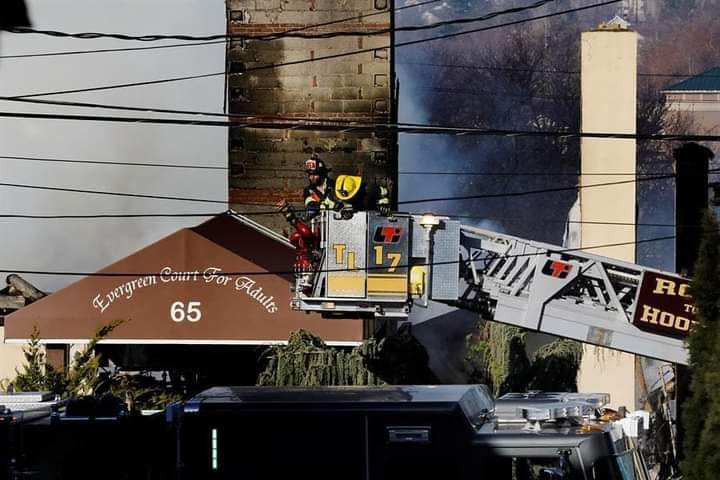
Update, March 24: The body of the missing firefighter has been recovered. The firefighter has not been publicly identified yet.
A 200-bed assisted living complex in Spring Valley, NY, is a total loss after a massive fire swept through it early Tuesday morning, killing one resident and possibly a firefighter, who remained missing as of press time. A main takeaway from the tragedy for other senior living providers, according to one fire and safety expert, is their responsibility to “go above and beyond”
According to a news release from the Spring Valley Police Department, a 911 call of a fire at the Evergreen Court Home for Adults came in just before 1 a.m. A large fire already was burning when the first officer arrived, and an evacuation of the complex’s more than 100 residents began immediately. At least 23 fire departments responded to a mutual aid call. The second floor of the facility can be seen collapsing in video from the scene.
One resident was transported to the hospital and died, and a volunteer firefighter with the Spring Valley Fire Department, who was on an upper floor to evacuate residents, went missing after sending a “mayday” signal, according to published reports. Two other firefighters were injured, as were up to 10 residents, according to various published reports about the fire.
Other residents were taken by bus to another nearby facility, according to published reports. Evergreen Court Home for Adults is about 37 miles north of New York City.
The complex received a total of 27 violations resulting from six inspections between Oct. 1, 2016, and Sept. 30, 2020, according to the New York State Department of Health. No enforcement actions were taken against the operator during the reporting period.
Violations were related to administration education and facility environmental standards, including maintenance, renovation or remodeling, smoke and fire protection, furnishings and equipment, and housekeeping, as well as resident supervision, medication management and food service. Sixteen citations were cited during a December 2019 relicensure survey.
Going above and beyond
Stan Szpytek, president of Fire and Life Safety of Mesa, AZ, said the main takeaway from this tragedy for senior living providers is that their responsibility is to “go above and beyond” minimal environmental requirements when it comes to protecting a vulnerable population — residents.
Szpytek called the Spring Valley fire a “nightmare scenario,” with firefighters risking their own safety to save the lives of others. He pointed out that 75% of firefighters in the country are volunteers, adding that many of the departments responding to the Spring Valley fire were staffed by volunteer firefighters.
“They will risk a lot to save a lot,” Szpytek said.
A former deputy fire chief and fire marshal for Palos Fire Protection District in suburban Chicago, Szpytek works with individual long-term care providers on life safety and emergency preparedness. That includes educating residents on how to be safe in their buildings — knowing the exits, avoiding the use of candles, and being safe with electricity. He also works directly with state associations, including the Arizona Health Care Association, the California Association of Health Facilities and the Utah Health Care Association.
“It’s a programmatic approach. Not only is the burden on the staff and ownership, but responsibility lies with the residents themselves, especially in independent environments where residents come and go,” Szpytek said. “They’ve got to be instructed on how to be prepared and how to do things safely.”
Szpytek said that collaboration is key, and operators should contact their local jurisdiction, fire department or building department to ensure that their buildings are up to code. Also, he said, providers should be mindful and in compliance with state regulations for assisted living.
“It’s not just about a fire alarm system, a sprinkler system or an emergency generator. It’s training and awareness — making sure your team members know and understand and are proficient in emergency procedures,” he said. “My mission, generally, is to educate these folks to go above and beyond what is minimally required, as we know this population is so vulnerable.”




